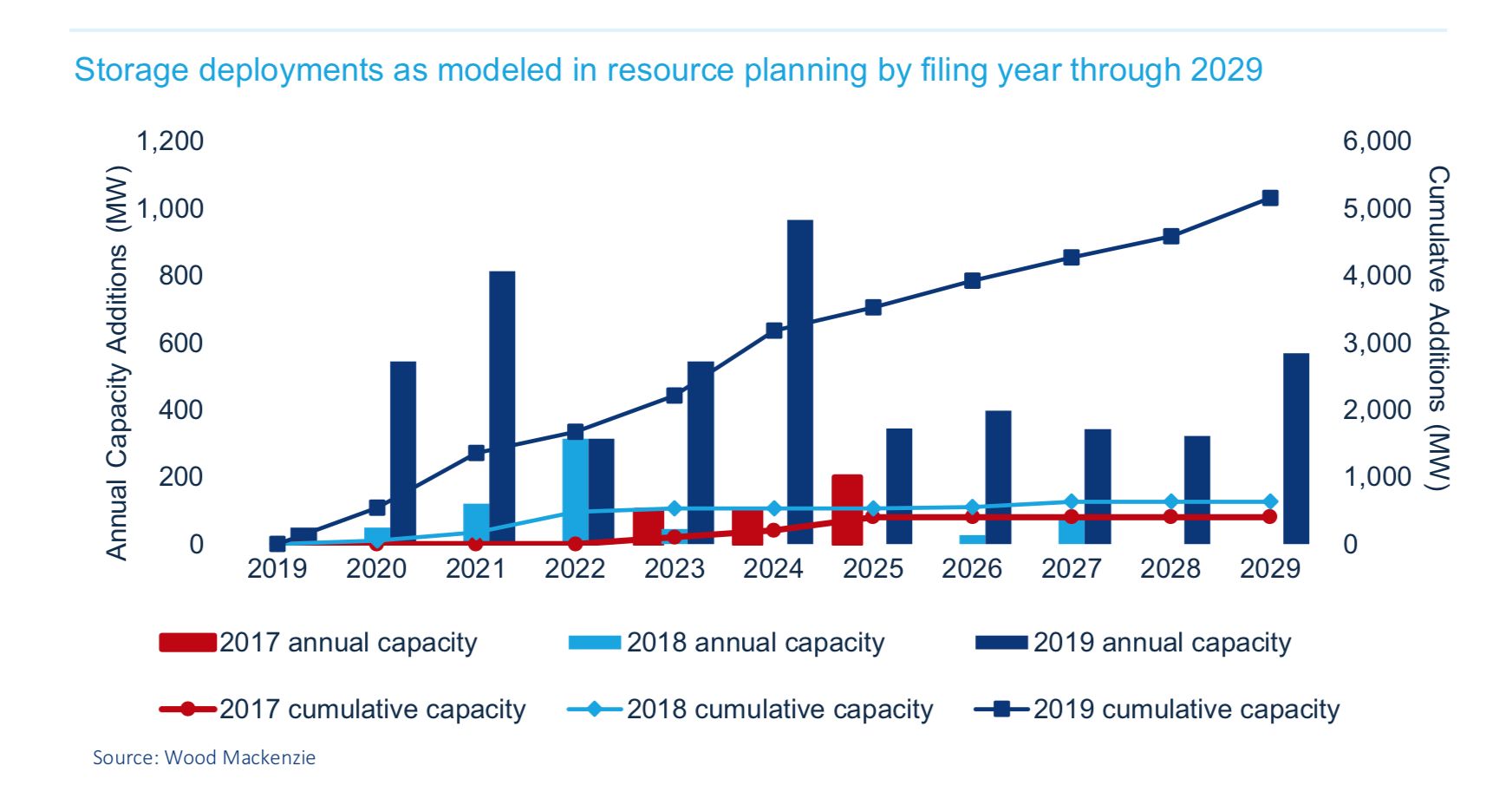For almost every year in the historical record, utilities paid no attention to battery storage.
Because of this, the past offers little insight into how quickly utilities will adopt the technology, which helps integrate renewables onto the grid, deliver peak capacity without carbon emissions, instantly adjust the frequency of the system and more.
As costs have fallen and early adopters liked what they saw from initial trials, though, the cycle from pilot to evaluation to widespread adoption is speeding up. The storage industry, and advocates of low-carbon electricity, have a lot riding on that process.
A new analysis sheds some light on how that adoption cycle works. Wood Mackenzie storage researcher Gregson Curtin tallied up utility integrated resource plans from the last three years (those are the documents where companies tell the world what power plants they expect to build in the coming years).
In 2017, almost none of the 43 utilities that Curtin surveyed expected to build any energy storage. The official outlook from that year suggested storage would not play a meaningful role in grid operations during the 2020s.
In 2018, six utilities decided to pencil in some battery procurement, amounting to a smidge more capacity expected online in the coming decade.
But the next year, everything changed: The 10 utilities planning to install storage in their 2019 integrated resource plans called for five times more capacity, on average, than the utilities including it in their 2018 plans.
As a result, the combined resource plans now anticipate 6.3 gigawatts of battery deployments from 2020 to 2029. The Tennessee Valley Authority, the Puerto Rico Electric Power Authority and PacifiCorp led in expected deployments during that decade.
That spike in interest reflects a learning process, where small pilot projects give utilities operational experience with the technology, and the results encourage them to expand their ambitions, Curtin said.
“Once utilities test energy storage and like it, they keep procuring more and more,” he said.
It would be difficult to find a clearer example than Florida Power & Light, which built a 10-megawatt pilot system and now is following up with a planned 409-megawatt system. That project, due by the end of 2021, will be bigger than any other lithium-ion battery system in the world. Duke Energy experienced a similar growth in appetite; a handful of sub-megawatt-scale pilots encouraged the utility to call for 300 megawatts across its Carolina territory.
It's important to note that this analysis does not fully capture energy storage uptake. For one thing, long-range plans differ from actual procurements; utilities sometimes buy more, sometimes less of a resource than they had expected to. Also, the integrated resource plan (IRP) data points come primarily from regulated utility markets that engage in long-term planning of electricity supply; additional construction is already underway from independent developers in competitive markets.
Even in regulated markets, energy storage interest does not always register in IRPs. Arizona Public Service’s 2018 IRP called for massive investment in gas capacity; the following year, the utility announced an 850-megawatt storage deployment spree, and this week it committed to 45 percent renewables by 2030. That massive ramp in storage ambitions transpired before the release of a new IRP, which will eventually reflect the change.
Grid edge entrepreneurs often bemoan “death by pilot,” where utilities run small-scale tests of promising technologies but never move to widespread deployment. Market observers might wonder why a utility like Dominion Energy still feels the need to test whether batteries can store solar power for use later on, when a utility like APS has already awarded contracts for full-scale solar-battery peaker plants.
But utilities need to feel comfortable with how batteries perform before they can integrate them into system planning and grow their fleets.
“One of the biggest impediments right now is operational experience with battery energy storage,” Curtin noted.
Falling prices for batteries also help avoid the death-by-pilot phenomenon, because project economics keep getting better. WoodMac's analysis found that utilities often rely on outdated pricing for their storage models, meaning actual bids frequently beat expectations.
***
The full insight, 'US utility battery storage deployments to surpass utility expectations in IRPs,' is available for purchase.





